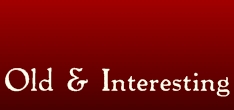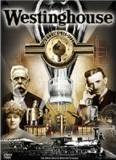-
History of:
- Resources about:
- More:
- Baby walkers
- Bakehouses
- Bed warmers
- Beer, ale mullers
- Besoms, broom-making
- Box, cabinet, and press beds
- Butter crocks, coolers
- Candle snuffers, tallow
- Clothes horses, airers
- Cooking on a peat fire
- Drying grounds
- Enamel cookware
- Fireplaces
- Irons for frills & ruffles
- Knitting sheaths, belts
- Laundry starch
- Log cabin beds
- Lye and chamber-lye
- Mangles
- Marseilles quilts
- Medieval beds
- Rag rugs
- Rushlights, dips & nips
- Straw mattresses
- Sugar cutters - nips & tongs
- Tablecloths
- Tinderboxes
- Washing bats and beetles
- Washing dollies
- List of all articles
Subscribe to RSS feed or get email updates.
The electric flat iron plays also an important part in the laundry as it is clean and never gets too hot nor too cold and there is no rushing back to replenish the heaters. One is not obliged to remain in the room with a hot stove, and suffer the inconveniences. No heat is felt at all from the iron as it is all concentrated on the bottom surface. It is a regular blessing to the laundress especially in hot weather. There is a growing demand in all parts of the country [USA] for these electric flat-irons.
Paul Severing, Marvels of Modern Science, c1910
The electrical exhibition officially opened by Sir William Preece at Olympia, London, on Saturday illustrates in a striking way the remarkable developments which have taken place in recent years in every branch of electrical science.
... Practical demonstrations are given of laundry work, electric irons and other up-to-date apparatus being used.
The Scotsman, 1911
Then the epoch has appeared which may be properly styled the "Happy" or "Golden Age". For many cares and sorrows will be removed at once. The conscientious housekeeper, for instance, whose domestic duties often exhaust her bodily strength, will find her burdens greatly lightened. She has no more to suffer from the intolerable heat of her cooking-stove...
...In like manner the electric flat-iron will smoothen her linen without fatiguing her. But not only the lady of the house will rejoice; also the poor, hen-pecked husband will be in transports of delight, as it will make his path easier in many ways. The constant complaints he was hitherto obliged to endure, will grow mute for ever...
Johanna S. Wisthaler, By Water to the Columbian Exposition, 1894
Sales of vacuum cleaners in 1924 are estimated at 1,250,000, valued at $69,000,000, and of electric irons 2,500,000 valued at $14,750,000.
New York Times, 1925
Electric Iron Wins Poll, with Radio Set Second
A radio receiving set is the most essential household electrical appliance, next to the electric iron, according to a survey among 1017 housewives in New Jersey conducted by McCall's Magazine. The votes were as follows: irons, 68.9 per cent; radios, 64.4; vacuum cleaners, 63.3; refrigerators, 38; washing machines, 36.3.
New York Times, 1935

DVD about Westinghouse history, including its rivalry with Edison's General Electric, from Amazon.com
Early electric irons
Electrical self-heating flat-irons, electric sad-irons
 The search for a foolproof "self-heating flat
iron" was under way by the mid-19th century. In 1852 a patent was issued in the
US for a new, improved charcoal-burning iron which would make "practicable
the permanent heating of smoothing irons". By 1860 there were
gas irons available in several countries, with rubber tubing to connect
them to gas light fittings or to canisters, and then there were numerous designs
for irons with internal burners and little piggyback tanks of liquid fuel.
The search for a foolproof "self-heating flat
iron" was under way by the mid-19th century. In 1852 a patent was issued in the
US for a new, improved charcoal-burning iron which would make "practicable
the permanent heating of smoothing irons". By 1860 there were
gas irons available in several countries, with rubber tubing to connect
them to gas light fittings or to canisters, and then there were numerous designs
for irons with internal burners and little piggyback tanks of liquid fuel.
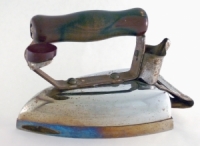 Any inventor who had ever been near the room where ironing was done knew it
was a hot, tiring job. Whatever the weather, the housewife/laundress would work
beside a hot stove or hearth, with at least two irons, probably three, moving them
from stove to ironing table and back again in a cycle of heating, pressing and re-heating.
Meanwhile she must keep the irons spotlessly clean with no trace of ash to soil
the clean linen.
Any inventor who had ever been near the room where ironing was done knew it
was a hot, tiring job. Whatever the weather, the housewife/laundress would work
beside a hot stove or hearth, with at least two irons, probably three, moving them
from stove to ironing table and back again in a cycle of heating, pressing and re-heating.
Meanwhile she must keep the irons spotlessly clean with no trace of ash to soil
the clean linen.
As we now know, the electric iron solved these problems better than any other self-heating
apparatus, while charcoal-filled
irons remain popular today in many less-electrified parts of the world.
By the early 1880s more than one person had considered powering ironing with electricity,
but Henry W. Seely of New York was the first inventor to make
this idea workable and patent it too. Seely developed a design in 1881, got a patent
in 1882, and then worked with his partner, Dyer, to patent a different "electric
flat iron" in 1883.
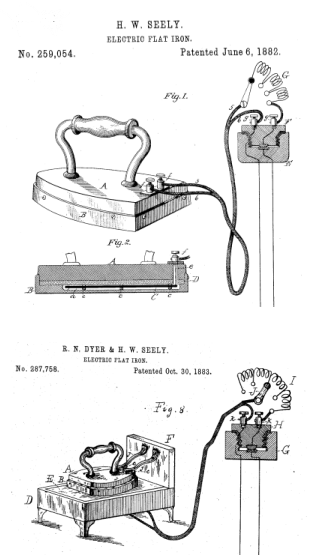 Seely and Dyer had doubts about having the iron continuously plugged in, as "connecting
[it] permanently with the circuit [...] may be inconvenient in some cases". They
invented a sort of "cordless" iron, on a stand heated by electricity. (Lower picture
left) This echoed developments in using gas for ironing, where gas-fed iron-heaters
or ironing-stoves were serious rivals to irons on lengths of rubber tubing.
Seely and Dyer had doubts about having the iron continuously plugged in, as "connecting
[it] permanently with the circuit [...] may be inconvenient in some cases". They
invented a sort of "cordless" iron, on a stand heated by electricity. (Lower picture
left) This echoed developments in using gas for ironing, where gas-fed iron-heaters
or ironing-stoves were serious rivals to irons on lengths of rubber tubing.
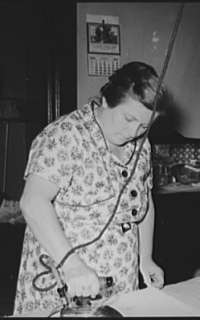 Uncertain claims that there was an even earlier electric iron in France seem
to be connected with
two different dates given to an
early French iron in London's Science Museum. However,
this French museum expert is sceptical about such claims.
Uncertain claims that there was an even earlier electric iron in France seem
to be connected with
two different dates given to an
early French iron in London's Science Museum. However,
this French museum expert is sceptical about such claims.
By the early 20th century enthusiasm was building for the new electric smoothing irons: clean, powerful, adjustable, and labour-saving.
...not only the lady of the house will rejoice; also the poor, hen-pecked husband will be in transports of delight...
(Johanna Wisthaler, 1894 - see left-hand column)
They didn't make you roasting hot, and they didn't carry soot or ash. As the advertisement says, they were better than three flat irons. And yet, there were still plenty of traditionalists who stuck with flat irons (aka sad irons) well into the middle of the 20th century, even when they lived in a home with a good electricity supply.
The Hotpoint iron,
designed by Earl H. Richardson of Ontario, California, was launched in 1905, and
was the first electric iron to have any commercial success. By the 1920s enough
people had homes wired for electricity for electric clothes irons to spread fast
across the US. They were also selling well in some parts of Europe. By 1932 17.5
percent of Swiss homes had one, more than in the US, according to
Iván Berend in
An Economic History of Twentieth-Century Europe.
The Waage ad (above right) for an iron with hot, medium, and low settings, appeared in the 1920s. By the 1930s the iron's only rival for "most popular electrical home appliance" was the radio. In 1941 79 per cent of American households had an electric iron, according to the Monthly Labor Review for December 1945.
I, Henry W. Seely... have invented a new and useful electric flat-iron...
The object of my invention is to utilize electric currents derived from any suitable source of electric energy for the purpose of heating flat-irons, fluting-irons, and other similar utensils. To accomplish this object I place within the iron and close to its face a resistance, preferably of carbon, and of such size and shape that it will heat the face of the irons sufficiently and equally. This resistance has terminals, by means of which it may be connected in an electric circuit, preferably a multiple arc circuit of an electric lighting system.... (Written in 1881)
More about vintage electric irons
Note that most of the early irons have the electric cord pointing upward towards a ceiling light fitting.
- Electric irons, from 1919
- 'Smoothwell' electric iron, 1935
- Irons with thermostatic controls, from 1935
- HMV 'Ceramic' electric iron, c 1936
For the 1883 patent, Seely and Dyer wrote:
...The other object being to provide a more durable flat-iron, and one which can be more readily repaired in the old form, and also to provide a means for heating such irons without connecting them permanently with the circuit, which may be inconvenient in some cases. In carrying out our invention we use, as the heating resistance contained in the base of the iron, instead of the carbon sticks of the patent referred to, a layer of some pulverized or finely divided substance which is a highly resistant conductor of electricity. This may be lamp black or powdered carbon of other character...
 29 August 2007
29 August 2007
Who was Henry W. Seely?
WARNING Watch out for incorrect biographical information repeated on various websites - probably a hoax - scroll down for more info.
Biographical information on Henry W. Seely is scarce, but we know he was connected with people who are better-known figures in American history.
In 1882 he kept only one third of the rights in his now his famous electric flat-iron patent and assigned the other two thirds to Samuel Insull and Richard N. Dyer, Thomas Edison's patent attorney. At that time Seely was in New York City, but in 1883 patent documents say he was "of Menlo Park, New Jersey".
He was a witness to many of Edison's patents, including his 1881 "incandescing electric lamp". For a couple of years in the early 1880s the H. W. Seely signature appeared on more than 100 patents, and he went on acting as an occasional witness up to 1892.
Henry W. Seely was in partnership with Dyer for some years, but Dyer had other legal/business partnerships too. Dyer & Seely are often mentioned in a collection of Edison's papers and the firm is named in New York Times reports of major legal cases defending Edison's light bulb and phonograph patents. But it was Dyer who appeared in court, not Seely. The Dyer family were socially prominent (in East Orange, NJ), but apparently Seely was not.
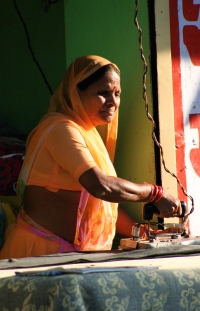 Did he have any idea how useful
and popular "his" invention might become? The 1883 patent suggests he and Dyer had
their doubts about the practicality of an iron that had to be hooked up to an electric
circuit. Was he right to doubt his own version of the electric iron? How much, if
anything, did Seely's invention have to do with Richardson's Hotpoint iron which
was successfully manufactured and marketed (unlike Seely's)?
Did he have any idea how useful
and popular "his" invention might become? The 1883 patent suggests he and Dyer had
their doubts about the practicality of an iron that had to be hooked up to an electric
circuit. Was he right to doubt his own version of the electric iron? How much, if
anything, did Seely's invention have to do with Richardson's Hotpoint iron which
was successfully manufactured and marketed (unlike Seely's)?
Warning: If you see a "biography" claiming Seely was born in Richville, KY, this is almost certainly based on an ehow page, now removed, that I believe started as a "joke". As far as I know there is no Richville, KY, and no evidence that Seely had 5 children, some with unusual names like Gintal. Dates and other details are probably bogus too. Unfortunately they have been picked up on various webpages, including another ehow page.
Please get in touch if you know more about Seely's life. I've done some preliminary research and hope to put together some more biographical info later this year.
See also:
- History of ironing
- Ironing boards
- Fluting and goffering irons
- Korean ironing sticks
- Charcoal irons with roosters
You may like our new sister site Home Things Past where you'll find articles about antiques, vintage kitchen stuff, crafts, and other things to do with home life in the past. There's space for comments and discussion too. Please do take a look and add your thoughts. (Comments don't appear instantly.)
For sources please refer to the books page, and/or the excerpts quoted on the pages of this website, and note that many links lead to museum sites. Feel free to ask if you're looking for a specific reference - feedback is always welcome anyway. Unfortunately, it's not possible to help you with queries about prices or valuation.
